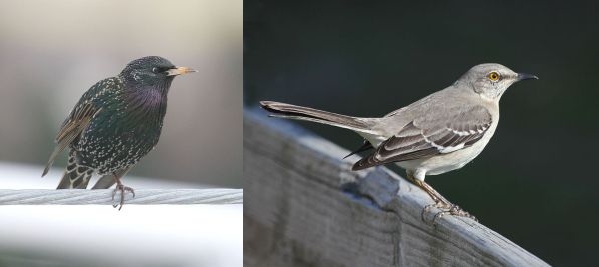
Earlier this month I watched a flock of robins and starlings feast on the Bradford pears near Heinz Chapel. Birds usually don’t sing in the fall but this flock was muttering and whisper-singing. Three birds in particular caught my ear.
A robin sang softly.
A starling mimicked the robin.
A mockingbird mimicked the starling mimicking the robin.
By the time the robin’s song came out of the mockingbird’s mouth it was nearly unrecognizable. (Click here for the robin’s song.)
European starlings, on the left above, are considered mimics but they have wiry voices that distort whatever they say. Here’s a typical starling song. At the 00:23 mark he does a good imitation of a house sparrow. I couldn’t find an audio clip of a starling mimicking a robin.
Northern mockingbirds, on the right, are much better mimics than starlings. They can follow a robin’s tune and cadence but miss the melodious thrush harmony. They brazenly mask this deficiency: “I meant to sing the tune without the harmony.” Click here to hear a mockingbird mimicking many birds, including robins.
The mockingbird at Heinz Chapel clearly copied the starling’s wiry song including his poor imitation of the robin.
It was like a game of telephone. There were two levels of distortion.
(European starling by Paul Carter via Wikimedia Commons. Northern mockingbird by Dick Daniels via Wikimedia Commons. Click on these imbedded links to see the original photos.)
So why do birds mimic? I am wondering what the evolutionary value is.
Do they do it for fun? Fun reduces stress. I’m sure birds feel stress.
Do they do it to fit in to their surroundings better?
Do they do it to practice their vocal capabilities?
Do they do it in attempt to communicate with another species?
I suppose that the regular “mockers” (mockingbirds, thrashers, catbirds) mock to create song. What can we make of the other instances?
I tend to lean towards fun.
Today at Heinz Chapel the starling flocks were huge — several hundred birds — and they were all chattering. E2 watched them from his 40th floor perch on the Cathedral of Learning. The starlings and pigeons grazed on the ground, then wheeled up and ate fruit on the ornamental trees. Sometimes the starlings would suddenly fall silent, then wheel in a flock and settle in another tree. When they landed they would chatter louder than before as if to say “Whew! We’re still alive. That peregrine didn’t eat us.”
I’ve been wondering why our local Oakland mockingbird(s?) were singing so much in Sept.-Oct. It’s not nesting season, but they were being very musical for some weeks.
Mockingbirds defend their winter territory too. Here’s an explanation of their fall song from Stokes: http://www.stokesbirdsathome.com/birding/behav/behavpages/behav109.html
Hi Kate,
I read this well after your posting. I loved your observation that the mockingbird’s imitation of the the starling’s imitation of a robin kept elements of both. And, since then you may have learned more about mimicry within the Mimidae (mockingbirds, catbirds and thrashers). If not, your final “suppose” was on the money. This family “builds” their songs from the snippets of songs they mimic and then stitch together to produce one complete song. Females of those species, apparently, preference males with longer songs that utilize more different sounds. The Sage Thrasher is the current champion, creating and singing songs that can last 10 minutes or more (the record is 22 minutes!). Even more astounding is that when these songs are recorded it has been found that when they reach the end and begin singing again, the second utterance is virtually identical to the first! A truly remarkable group of birds.